In-Depth Analysis: Foundation Phase EFAL Curriculum & Pedagogy
VerifiedAdded on 2023/04/25
|14
|3631
|169
Report
AI Summary
This report provides a comprehensive analysis of the Foundation Phase English First Additional Language (EFAL) curriculum. It examines whether the curriculum follows a competence or performance model, substantiating the answer with examples and quotes. It also explores the type of pedagogy expected from the curriculum, inferring teaching methods and approaches. The report assesses the clarity and realism of the curriculum's pacing, and evaluates the sufficiency of assignment guidelines for assessing EFAL competence, providing reasons and solutions. Finally, it identifies the strengths and weaknesses of the curriculum document and suggests potential changes, additions, removals, alterations, or amendments with detailed examples and justifications.
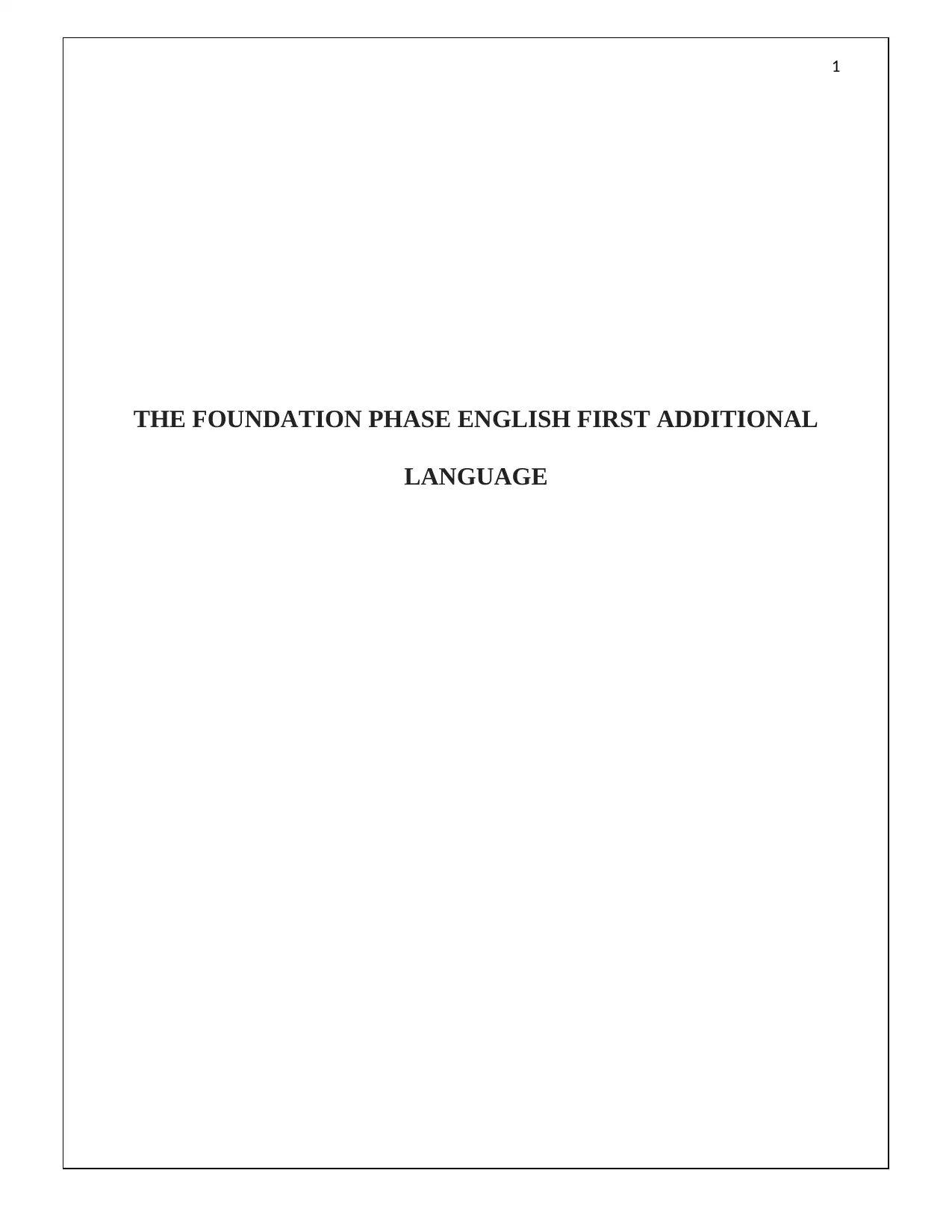
1
THE FOUNDATION PHASE ENGLISH FIRST ADDITIONAL
LANGUAGE
THE FOUNDATION PHASE ENGLISH FIRST ADDITIONAL
LANGUAGE
Paraphrase This Document
Need a fresh take? Get an instant paraphrase of this document with our AI Paraphraser
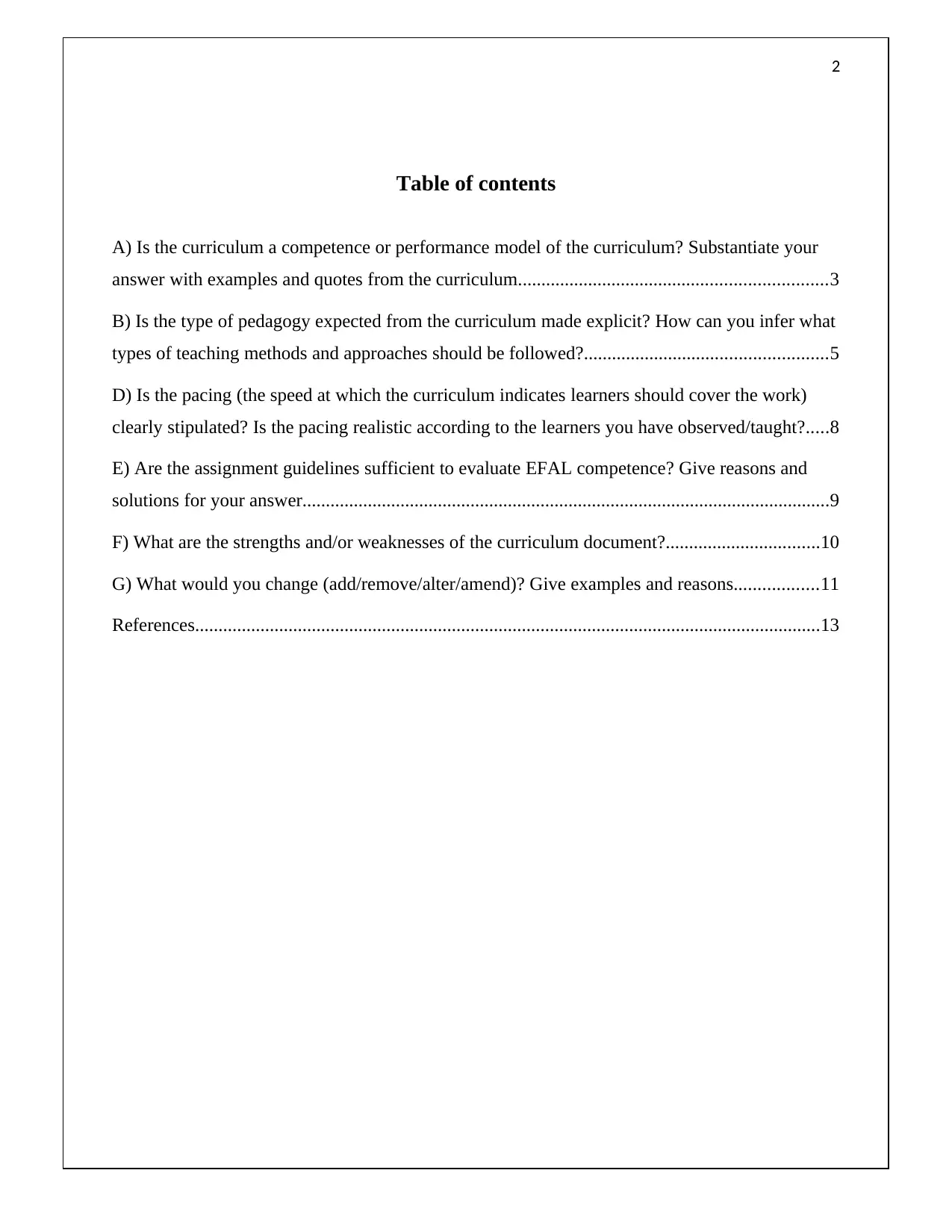
2
Table of contents
A) Is the curriculum a competence or performance model of the curriculum? Substantiate your
answer with examples and quotes from the curriculum..................................................................3
B) Is the type of pedagogy expected from the curriculum made explicit? How can you infer what
types of teaching methods and approaches should be followed?....................................................5
D) Is the pacing (the speed at which the curriculum indicates learners should cover the work)
clearly stipulated? Is the pacing realistic according to the learners you have observed/taught?.....8
E) Are the assignment guidelines sufficient to evaluate EFAL competence? Give reasons and
solutions for your answer.................................................................................................................9
F) What are the strengths and/or weaknesses of the curriculum document?.................................10
G) What would you change (add/remove/alter/amend)? Give examples and reasons..................11
References......................................................................................................................................13
Table of contents
A) Is the curriculum a competence or performance model of the curriculum? Substantiate your
answer with examples and quotes from the curriculum..................................................................3
B) Is the type of pedagogy expected from the curriculum made explicit? How can you infer what
types of teaching methods and approaches should be followed?....................................................5
D) Is the pacing (the speed at which the curriculum indicates learners should cover the work)
clearly stipulated? Is the pacing realistic according to the learners you have observed/taught?.....8
E) Are the assignment guidelines sufficient to evaluate EFAL competence? Give reasons and
solutions for your answer.................................................................................................................9
F) What are the strengths and/or weaknesses of the curriculum document?.................................10
G) What would you change (add/remove/alter/amend)? Give examples and reasons..................11
References......................................................................................................................................13
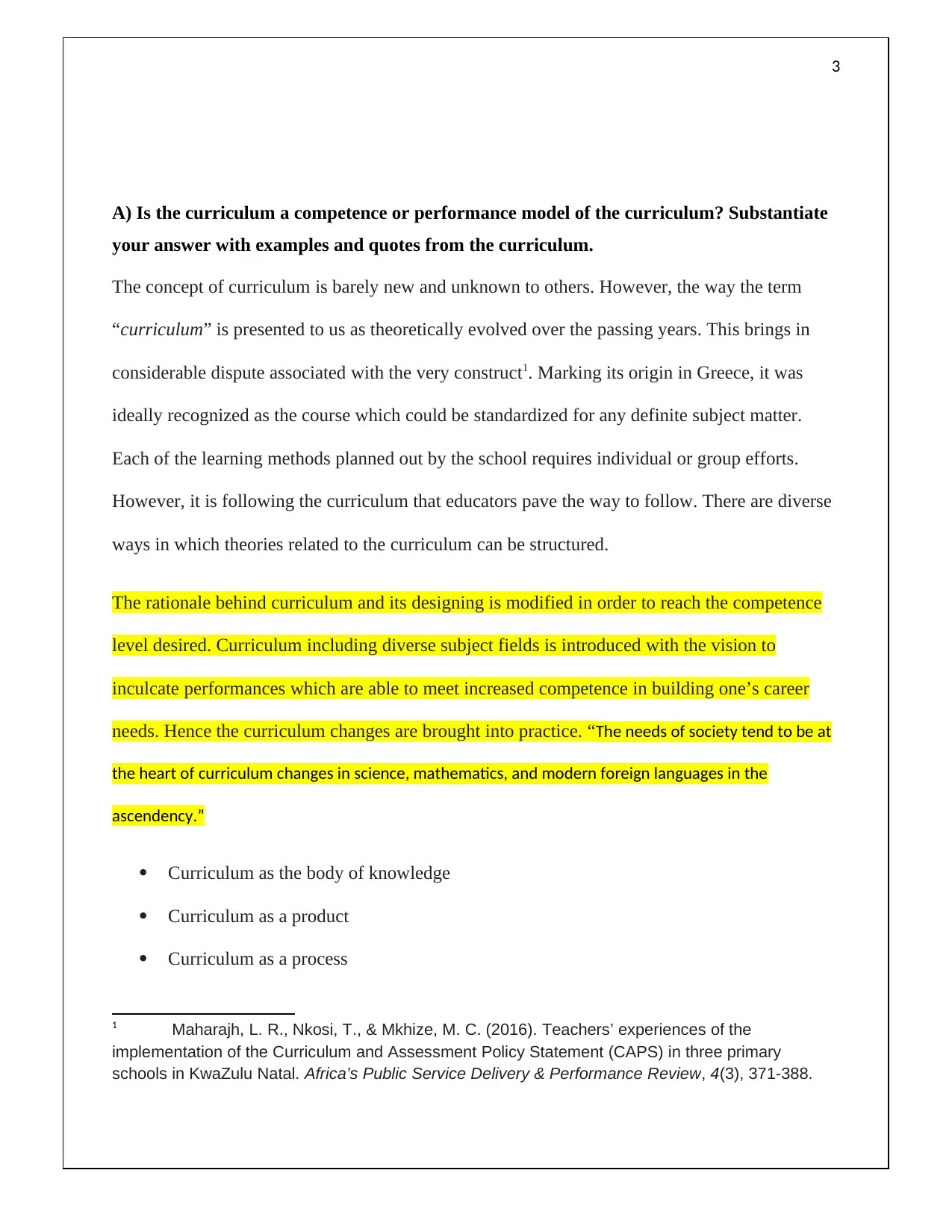
3
A) Is the curriculum a competence or performance model of the curriculum? Substantiate
your answer with examples and quotes from the curriculum.
The concept of curriculum is barely new and unknown to others. However, the way the term
“curriculum” is presented to us as theoretically evolved over the passing years. This brings in
considerable dispute associated with the very construct1. Marking its origin in Greece, it was
ideally recognized as the course which could be standardized for any definite subject matter.
Each of the learning methods planned out by the school requires individual or group efforts.
However, it is following the curriculum that educators pave the way to follow. There are diverse
ways in which theories related to the curriculum can be structured.
The rationale behind curriculum and its designing is modified in order to reach the competence
level desired. Curriculum including diverse subject fields is introduced with the vision to
inculcate performances which are able to meet increased competence in building one’s career
needs. Hence the curriculum changes are brought into practice. “The needs of society tend to be at
the heart of curriculum changes in science, mathematics, and modern foreign languages in the
ascendency.”
Curriculum as the body of knowledge
Curriculum as a product
Curriculum as a process
1 Maharajh, L. R., Nkosi, T., & Mkhize, M. C. (2016). Teachers’ experiences of the
implementation of the Curriculum and Assessment Policy Statement (CAPS) in three primary
schools in KwaZulu Natal. Africa’s Public Service Delivery & Performance Review, 4(3), 371-388.
A) Is the curriculum a competence or performance model of the curriculum? Substantiate
your answer with examples and quotes from the curriculum.
The concept of curriculum is barely new and unknown to others. However, the way the term
“curriculum” is presented to us as theoretically evolved over the passing years. This brings in
considerable dispute associated with the very construct1. Marking its origin in Greece, it was
ideally recognized as the course which could be standardized for any definite subject matter.
Each of the learning methods planned out by the school requires individual or group efforts.
However, it is following the curriculum that educators pave the way to follow. There are diverse
ways in which theories related to the curriculum can be structured.
The rationale behind curriculum and its designing is modified in order to reach the competence
level desired. Curriculum including diverse subject fields is introduced with the vision to
inculcate performances which are able to meet increased competence in building one’s career
needs. Hence the curriculum changes are brought into practice. “The needs of society tend to be at
the heart of curriculum changes in science, mathematics, and modern foreign languages in the
ascendency.”
Curriculum as the body of knowledge
Curriculum as a product
Curriculum as a process
1 Maharajh, L. R., Nkosi, T., & Mkhize, M. C. (2016). Teachers’ experiences of the
implementation of the Curriculum and Assessment Policy Statement (CAPS) in three primary
schools in KwaZulu Natal. Africa’s Public Service Delivery & Performance Review, 4(3), 371-388.
⊘ This is a preview!⊘
Do you want full access?
Subscribe today to unlock all pages.

Trusted by 1+ million students worldwide
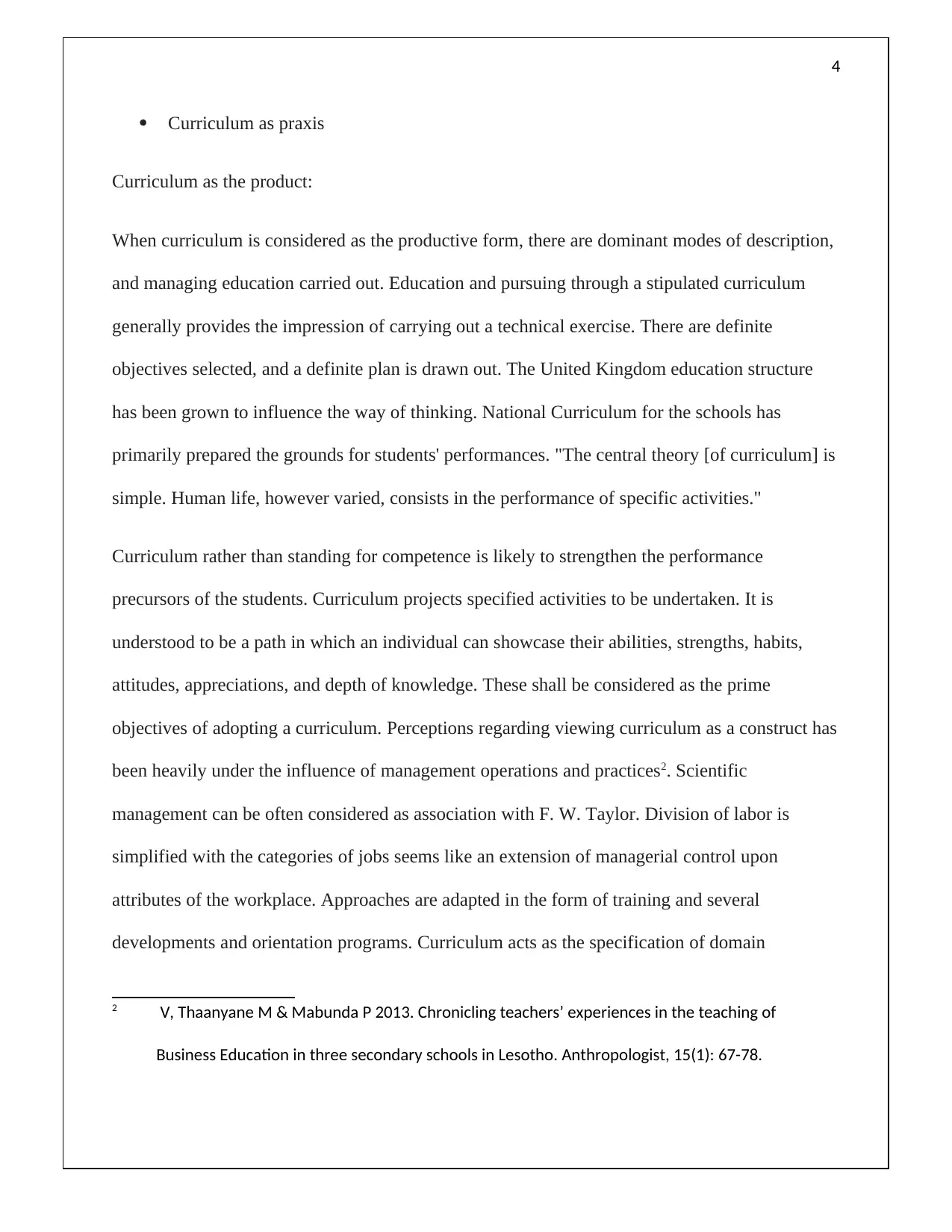
4
Curriculum as praxis
Curriculum as the product:
When curriculum is considered as the productive form, there are dominant modes of description,
and managing education carried out. Education and pursuing through a stipulated curriculum
generally provides the impression of carrying out a technical exercise. There are definite
objectives selected, and a definite plan is drawn out. The United Kingdom education structure
has been grown to influence the way of thinking. National Curriculum for the schools has
primarily prepared the grounds for students' performances. "The central theory [of curriculum] is
simple. Human life, however varied, consists in the performance of specific activities."
Curriculum rather than standing for competence is likely to strengthen the performance
precursors of the students. Curriculum projects specified activities to be undertaken. It is
understood to be a path in which an individual can showcase their abilities, strengths, habits,
attitudes, appreciations, and depth of knowledge. These shall be considered as the prime
objectives of adopting a curriculum. Perceptions regarding viewing curriculum as a construct has
been heavily under the influence of management operations and practices2. Scientific
management can be often considered as association with F. W. Taylor. Division of labor is
simplified with the categories of jobs seems like an extension of managerial control upon
attributes of the workplace. Approaches are adapted in the form of training and several
developments and orientation programs. Curriculum acts as the specification of domain
2 V, Thaanyane M & Mabunda P 2013. Chronicling teachers’ experiences in the teaching of
Business Education in three secondary schools in Lesotho. Anthropologist, 15(1): 67-78.
Curriculum as praxis
Curriculum as the product:
When curriculum is considered as the productive form, there are dominant modes of description,
and managing education carried out. Education and pursuing through a stipulated curriculum
generally provides the impression of carrying out a technical exercise. There are definite
objectives selected, and a definite plan is drawn out. The United Kingdom education structure
has been grown to influence the way of thinking. National Curriculum for the schools has
primarily prepared the grounds for students' performances. "The central theory [of curriculum] is
simple. Human life, however varied, consists in the performance of specific activities."
Curriculum rather than standing for competence is likely to strengthen the performance
precursors of the students. Curriculum projects specified activities to be undertaken. It is
understood to be a path in which an individual can showcase their abilities, strengths, habits,
attitudes, appreciations, and depth of knowledge. These shall be considered as the prime
objectives of adopting a curriculum. Perceptions regarding viewing curriculum as a construct has
been heavily under the influence of management operations and practices2. Scientific
management can be often considered as association with F. W. Taylor. Division of labor is
simplified with the categories of jobs seems like an extension of managerial control upon
attributes of the workplace. Approaches are adapted in the form of training and several
developments and orientation programs. Curriculum acts as the specification of domain
2 V, Thaanyane M & Mabunda P 2013. Chronicling teachers’ experiences in the teaching of
Business Education in three secondary schools in Lesotho. Anthropologist, 15(1): 67-78.
Paraphrase This Document
Need a fresh take? Get an instant paraphrase of this document with our AI Paraphraser
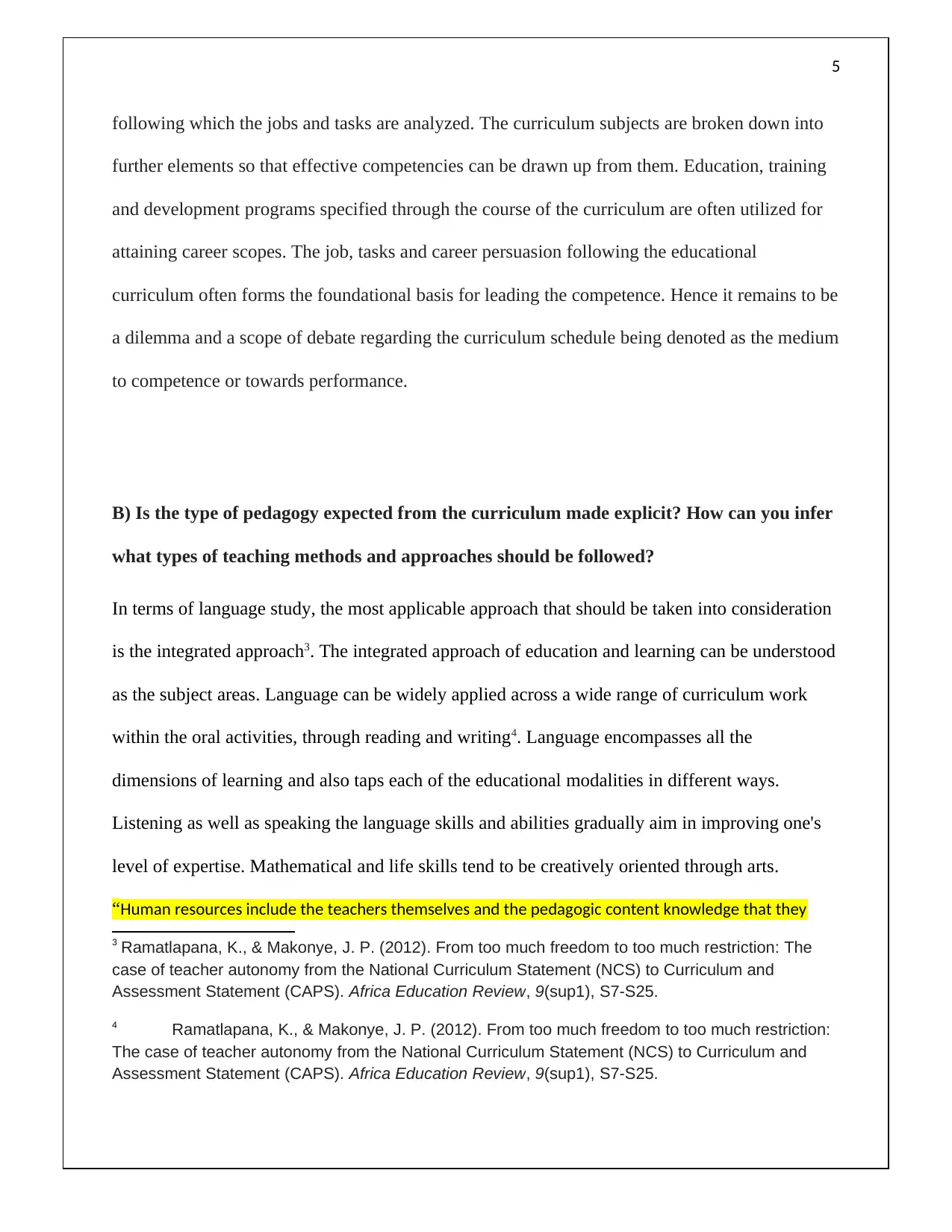
5
following which the jobs and tasks are analyzed. The curriculum subjects are broken down into
further elements so that effective competencies can be drawn up from them. Education, training
and development programs specified through the course of the curriculum are often utilized for
attaining career scopes. The job, tasks and career persuasion following the educational
curriculum often forms the foundational basis for leading the competence. Hence it remains to be
a dilemma and a scope of debate regarding the curriculum schedule being denoted as the medium
to competence or towards performance.
B) Is the type of pedagogy expected from the curriculum made explicit? How can you infer
what types of teaching methods and approaches should be followed?
In terms of language study, the most applicable approach that should be taken into consideration
is the integrated approach3. The integrated approach of education and learning can be understood
as the subject areas. Language can be widely applied across a wide range of curriculum work
within the oral activities, through reading and writing4. Language encompasses all the
dimensions of learning and also taps each of the educational modalities in different ways.
Listening as well as speaking the language skills and abilities gradually aim in improving one's
level of expertise. Mathematical and life skills tend to be creatively oriented through arts.
“Human resources include the teachers themselves and the pedagogic content knowledge that they
3 Ramatlapana, K., & Makonye, J. P. (2012). From too much freedom to too much restriction: The
case of teacher autonomy from the National Curriculum Statement (NCS) to Curriculum and
Assessment Statement (CAPS). Africa Education Review, 9(sup1), S7-S25.
4 Ramatlapana, K., & Makonye, J. P. (2012). From too much freedom to too much restriction:
The case of teacher autonomy from the National Curriculum Statement (NCS) to Curriculum and
Assessment Statement (CAPS). Africa Education Review, 9(sup1), S7-S25.
following which the jobs and tasks are analyzed. The curriculum subjects are broken down into
further elements so that effective competencies can be drawn up from them. Education, training
and development programs specified through the course of the curriculum are often utilized for
attaining career scopes. The job, tasks and career persuasion following the educational
curriculum often forms the foundational basis for leading the competence. Hence it remains to be
a dilemma and a scope of debate regarding the curriculum schedule being denoted as the medium
to competence or towards performance.
B) Is the type of pedagogy expected from the curriculum made explicit? How can you infer
what types of teaching methods and approaches should be followed?
In terms of language study, the most applicable approach that should be taken into consideration
is the integrated approach3. The integrated approach of education and learning can be understood
as the subject areas. Language can be widely applied across a wide range of curriculum work
within the oral activities, through reading and writing4. Language encompasses all the
dimensions of learning and also taps each of the educational modalities in different ways.
Listening as well as speaking the language skills and abilities gradually aim in improving one's
level of expertise. Mathematical and life skills tend to be creatively oriented through arts.
“Human resources include the teachers themselves and the pedagogic content knowledge that they
3 Ramatlapana, K., & Makonye, J. P. (2012). From too much freedom to too much restriction: The
case of teacher autonomy from the National Curriculum Statement (NCS) to Curriculum and
Assessment Statement (CAPS). Africa Education Review, 9(sup1), S7-S25.
4 Ramatlapana, K., & Makonye, J. P. (2012). From too much freedom to too much restriction:
The case of teacher autonomy from the National Curriculum Statement (NCS) to Curriculum and
Assessment Statement (CAPS). Africa Education Review, 9(sup1), S7-S25.
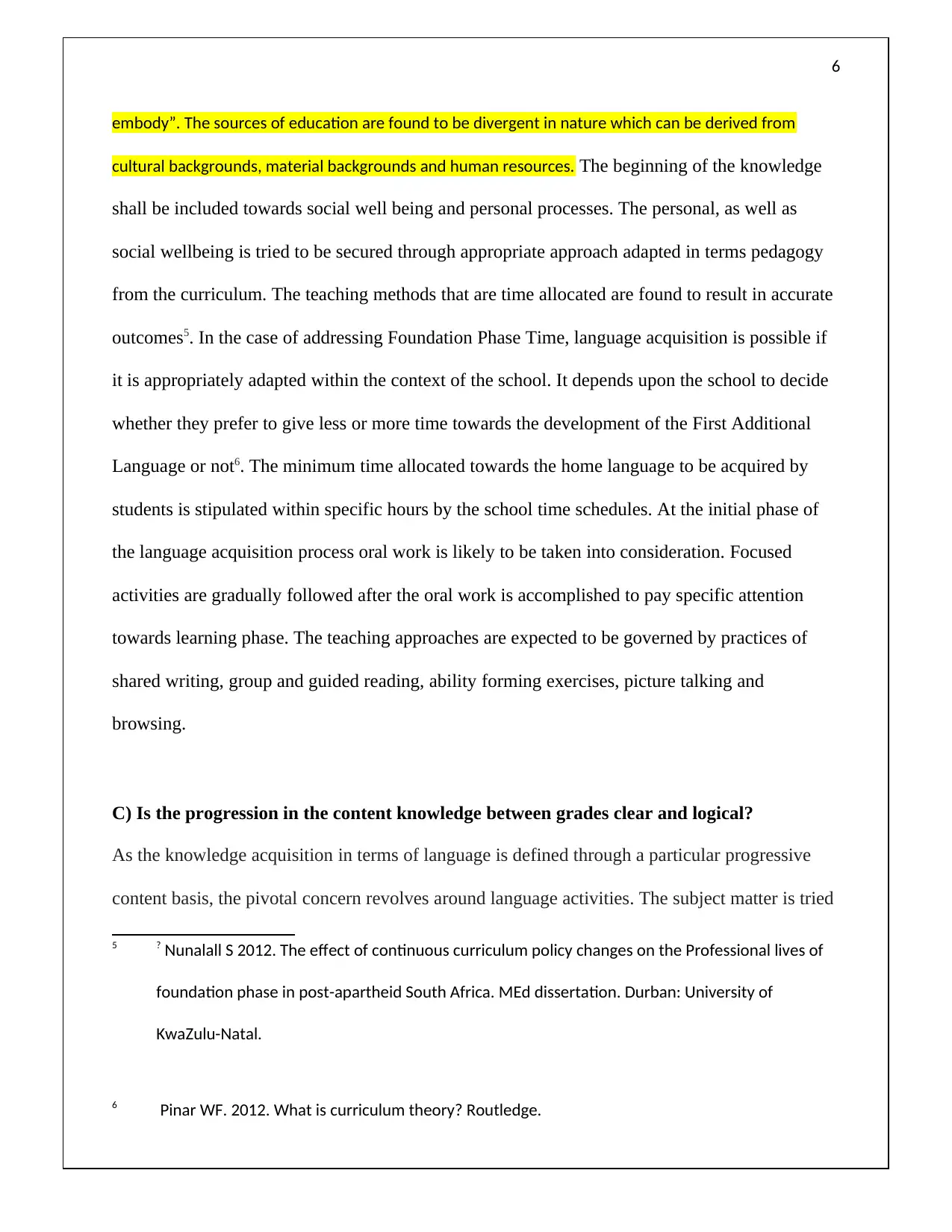
6
embody”. The sources of education are found to be divergent in nature which can be derived from
cultural backgrounds, material backgrounds and human resources. The beginning of the knowledge
shall be included towards social well being and personal processes. The personal, as well as
social wellbeing is tried to be secured through appropriate approach adapted in terms pedagogy
from the curriculum. The teaching methods that are time allocated are found to result in accurate
outcomes5. In the case of addressing Foundation Phase Time, language acquisition is possible if
it is appropriately adapted within the context of the school. It depends upon the school to decide
whether they prefer to give less or more time towards the development of the First Additional
Language or not6. The minimum time allocated towards the home language to be acquired by
students is stipulated within specific hours by the school time schedules. At the initial phase of
the language acquisition process oral work is likely to be taken into consideration. Focused
activities are gradually followed after the oral work is accomplished to pay specific attention
towards learning phase. The teaching approaches are expected to be governed by practices of
shared writing, group and guided reading, ability forming exercises, picture talking and
browsing.
C) Is the progression in the content knowledge between grades clear and logical?
As the knowledge acquisition in terms of language is defined through a particular progressive
content basis, the pivotal concern revolves around language activities. The subject matter is tried
5 ? Nunalall S 2012. The effect of continuous curriculum policy changes on the Professional lives of
foundation phase in post-apartheid South Africa. MEd dissertation. Durban: University of
KwaZulu-Natal.
6 Pinar WF. 2012. What is curriculum theory? Routledge.
embody”. The sources of education are found to be divergent in nature which can be derived from
cultural backgrounds, material backgrounds and human resources. The beginning of the knowledge
shall be included towards social well being and personal processes. The personal, as well as
social wellbeing is tried to be secured through appropriate approach adapted in terms pedagogy
from the curriculum. The teaching methods that are time allocated are found to result in accurate
outcomes5. In the case of addressing Foundation Phase Time, language acquisition is possible if
it is appropriately adapted within the context of the school. It depends upon the school to decide
whether they prefer to give less or more time towards the development of the First Additional
Language or not6. The minimum time allocated towards the home language to be acquired by
students is stipulated within specific hours by the school time schedules. At the initial phase of
the language acquisition process oral work is likely to be taken into consideration. Focused
activities are gradually followed after the oral work is accomplished to pay specific attention
towards learning phase. The teaching approaches are expected to be governed by practices of
shared writing, group and guided reading, ability forming exercises, picture talking and
browsing.
C) Is the progression in the content knowledge between grades clear and logical?
As the knowledge acquisition in terms of language is defined through a particular progressive
content basis, the pivotal concern revolves around language activities. The subject matter is tried
5 ? Nunalall S 2012. The effect of continuous curriculum policy changes on the Professional lives of
foundation phase in post-apartheid South Africa. MEd dissertation. Durban: University of
KwaZulu-Natal.
6 Pinar WF. 2012. What is curriculum theory? Routledge.
⊘ This is a preview!⊘
Do you want full access?
Subscribe today to unlock all pages.

Trusted by 1+ million students worldwide
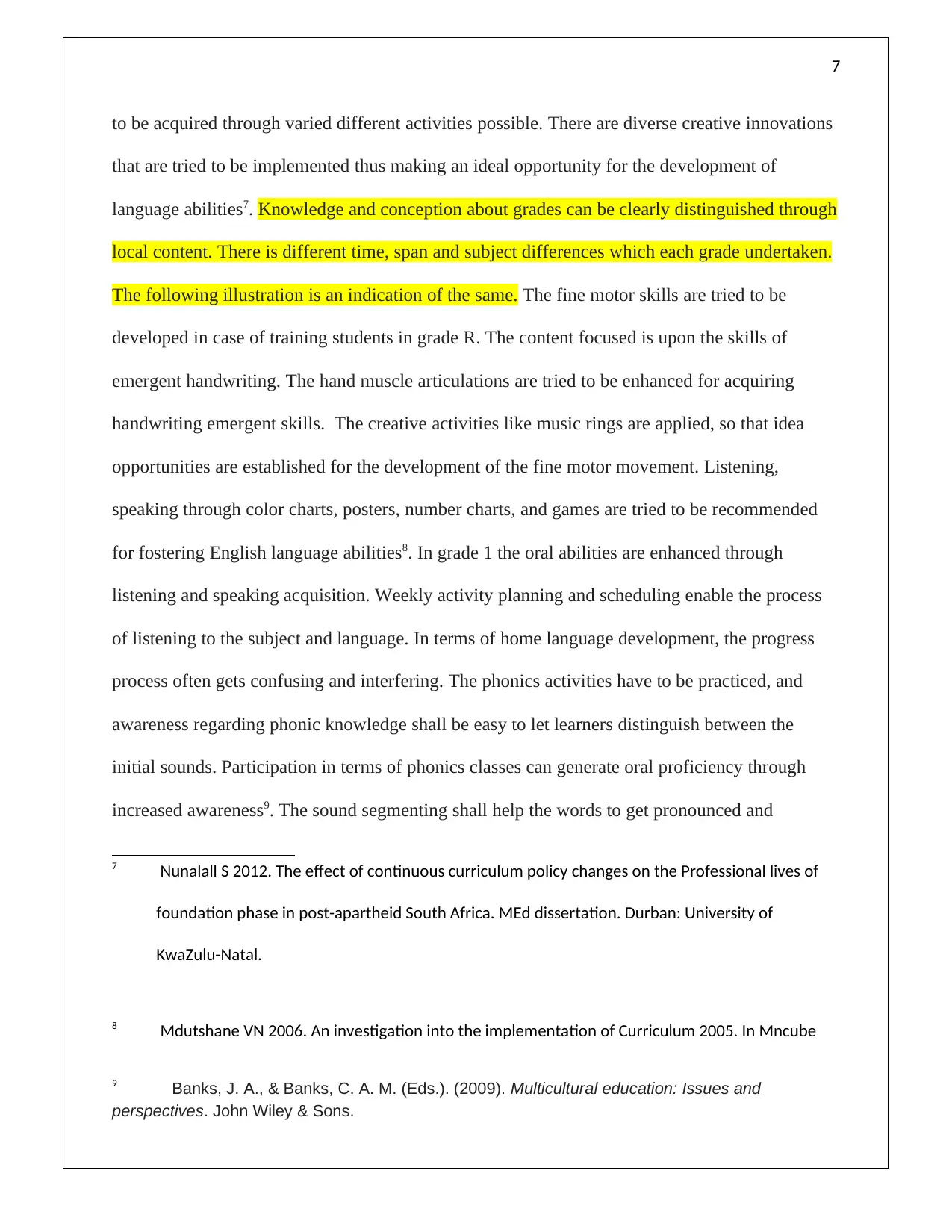
7
to be acquired through varied different activities possible. There are diverse creative innovations
that are tried to be implemented thus making an ideal opportunity for the development of
language abilities7. Knowledge and conception about grades can be clearly distinguished through
local content. There is different time, span and subject differences which each grade undertaken.
The following illustration is an indication of the same. The fine motor skills are tried to be
developed in case of training students in grade R. The content focused is upon the skills of
emergent handwriting. The hand muscle articulations are tried to be enhanced for acquiring
handwriting emergent skills. The creative activities like music rings are applied, so that idea
opportunities are established for the development of the fine motor movement. Listening,
speaking through color charts, posters, number charts, and games are tried to be recommended
for fostering English language abilities8. In grade 1 the oral abilities are enhanced through
listening and speaking acquisition. Weekly activity planning and scheduling enable the process
of listening to the subject and language. In terms of home language development, the progress
process often gets confusing and interfering. The phonics activities have to be practiced, and
awareness regarding phonic knowledge shall be easy to let learners distinguish between the
initial sounds. Participation in terms of phonics classes can generate oral proficiency through
increased awareness9. The sound segmenting shall help the words to get pronounced and
7 Nunalall S 2012. The effect of continuous curriculum policy changes on the Professional lives of
foundation phase in post-apartheid South Africa. MEd dissertation. Durban: University of
KwaZulu-Natal.
8 Mdutshane VN 2006. An investigation into the implementation of Curriculum 2005. In Mncube
9 Banks, J. A., & Banks, C. A. M. (Eds.). (2009). Multicultural education: Issues and
perspectives. John Wiley & Sons.
to be acquired through varied different activities possible. There are diverse creative innovations
that are tried to be implemented thus making an ideal opportunity for the development of
language abilities7. Knowledge and conception about grades can be clearly distinguished through
local content. There is different time, span and subject differences which each grade undertaken.
The following illustration is an indication of the same. The fine motor skills are tried to be
developed in case of training students in grade R. The content focused is upon the skills of
emergent handwriting. The hand muscle articulations are tried to be enhanced for acquiring
handwriting emergent skills. The creative activities like music rings are applied, so that idea
opportunities are established for the development of the fine motor movement. Listening,
speaking through color charts, posters, number charts, and games are tried to be recommended
for fostering English language abilities8. In grade 1 the oral abilities are enhanced through
listening and speaking acquisition. Weekly activity planning and scheduling enable the process
of listening to the subject and language. In terms of home language development, the progress
process often gets confusing and interfering. The phonics activities have to be practiced, and
awareness regarding phonic knowledge shall be easy to let learners distinguish between the
initial sounds. Participation in terms of phonics classes can generate oral proficiency through
increased awareness9. The sound segmenting shall help the words to get pronounced and
7 Nunalall S 2012. The effect of continuous curriculum policy changes on the Professional lives of
foundation phase in post-apartheid South Africa. MEd dissertation. Durban: University of
KwaZulu-Natal.
8 Mdutshane VN 2006. An investigation into the implementation of Curriculum 2005. In Mncube
9 Banks, J. A., & Banks, C. A. M. (Eds.). (2009). Multicultural education: Issues and
perspectives. John Wiley & Sons.
Paraphrase This Document
Need a fresh take? Get an instant paraphrase of this document with our AI Paraphraser
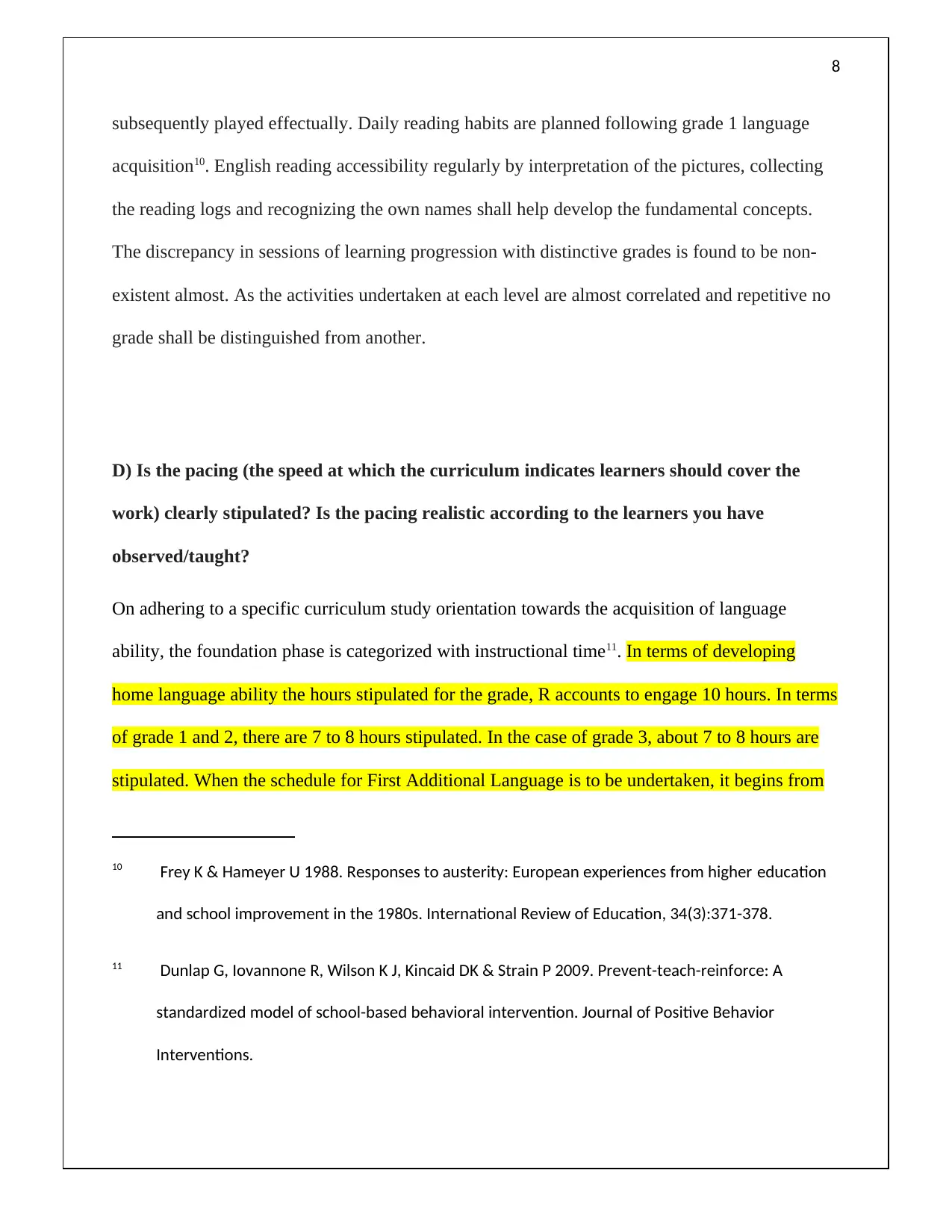
8
subsequently played effectually. Daily reading habits are planned following grade 1 language
acquisition10. English reading accessibility regularly by interpretation of the pictures, collecting
the reading logs and recognizing the own names shall help develop the fundamental concepts.
The discrepancy in sessions of learning progression with distinctive grades is found to be non-
existent almost. As the activities undertaken at each level are almost correlated and repetitive no
grade shall be distinguished from another.
D) Is the pacing (the speed at which the curriculum indicates learners should cover the
work) clearly stipulated? Is the pacing realistic according to the learners you have
observed/taught?
On adhering to a specific curriculum study orientation towards the acquisition of language
ability, the foundation phase is categorized with instructional time11. In terms of developing
home language ability the hours stipulated for the grade, R accounts to engage 10 hours. In terms
of grade 1 and 2, there are 7 to 8 hours stipulated. In the case of grade 3, about 7 to 8 hours are
stipulated. When the schedule for First Additional Language is to be undertaken, it begins from
10 Frey K & Hameyer U 1988. Responses to austerity: European experiences from higher education
and school improvement in the 1980s. International Review of Education, 34(3):371-378.
11 Dunlap G, Iovannone R, Wilson K J, Kincaid DK & Strain P 2009. Prevent-teach-reinforce: A
standardized model of school-based behavioral intervention. Journal of Positive Behavior
Interventions.
subsequently played effectually. Daily reading habits are planned following grade 1 language
acquisition10. English reading accessibility regularly by interpretation of the pictures, collecting
the reading logs and recognizing the own names shall help develop the fundamental concepts.
The discrepancy in sessions of learning progression with distinctive grades is found to be non-
existent almost. As the activities undertaken at each level are almost correlated and repetitive no
grade shall be distinguished from another.
D) Is the pacing (the speed at which the curriculum indicates learners should cover the
work) clearly stipulated? Is the pacing realistic according to the learners you have
observed/taught?
On adhering to a specific curriculum study orientation towards the acquisition of language
ability, the foundation phase is categorized with instructional time11. In terms of developing
home language ability the hours stipulated for the grade, R accounts to engage 10 hours. In terms
of grade 1 and 2, there are 7 to 8 hours stipulated. In the case of grade 3, about 7 to 8 hours are
stipulated. When the schedule for First Additional Language is to be undertaken, it begins from
10 Frey K & Hameyer U 1988. Responses to austerity: European experiences from higher education
and school improvement in the 1980s. International Review of Education, 34(3):371-378.
11 Dunlap G, Iovannone R, Wilson K J, Kincaid DK & Strain P 2009. Prevent-teach-reinforce: A
standardized model of school-based behavioral intervention. Journal of Positive Behavior
Interventions.
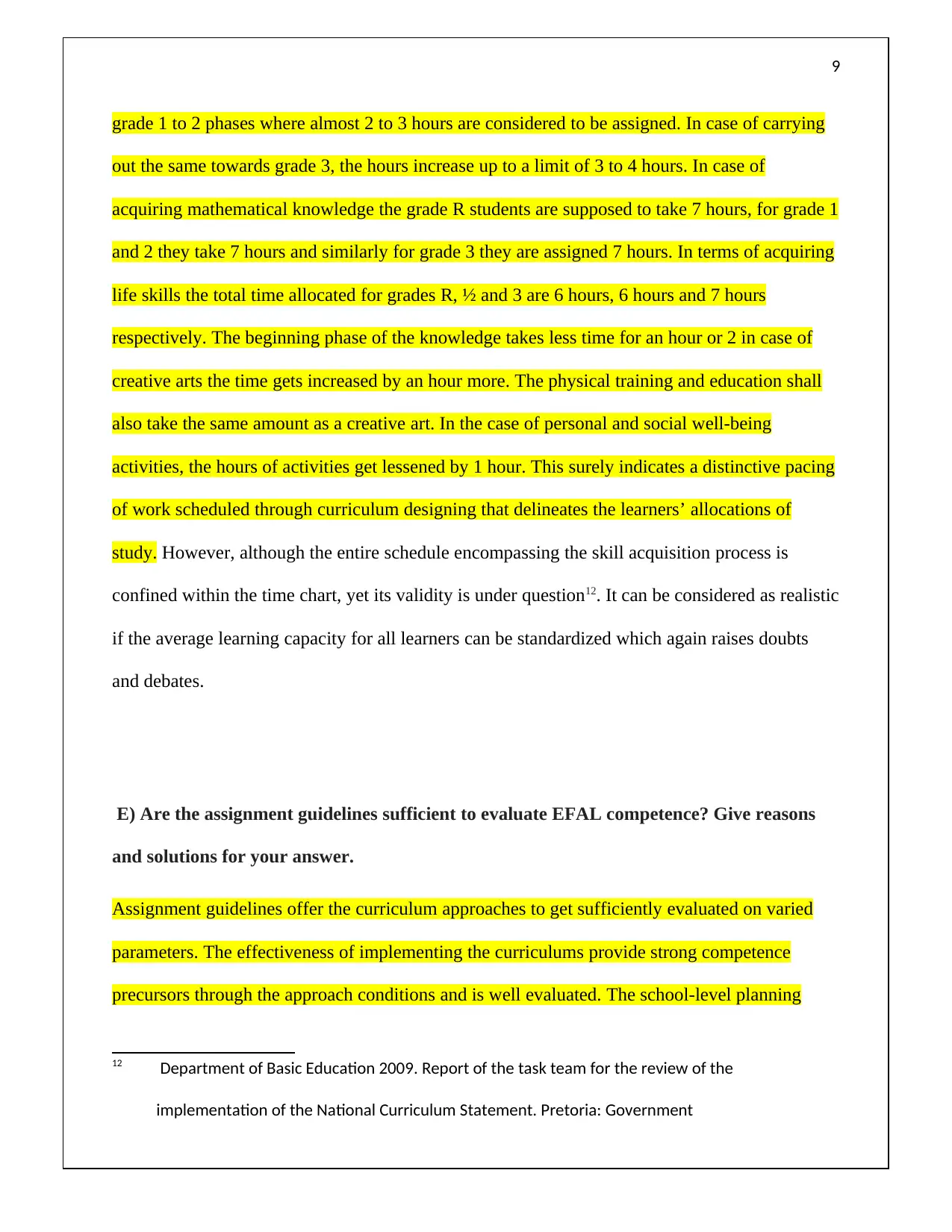
9
grade 1 to 2 phases where almost 2 to 3 hours are considered to be assigned. In case of carrying
out the same towards grade 3, the hours increase up to a limit of 3 to 4 hours. In case of
acquiring mathematical knowledge the grade R students are supposed to take 7 hours, for grade 1
and 2 they take 7 hours and similarly for grade 3 they are assigned 7 hours. In terms of acquiring
life skills the total time allocated for grades R, ½ and 3 are 6 hours, 6 hours and 7 hours
respectively. The beginning phase of the knowledge takes less time for an hour or 2 in case of
creative arts the time gets increased by an hour more. The physical training and education shall
also take the same amount as a creative art. In the case of personal and social well-being
activities, the hours of activities get lessened by 1 hour. This surely indicates a distinctive pacing
of work scheduled through curriculum designing that delineates the learners’ allocations of
study. However, although the entire schedule encompassing the skill acquisition process is
confined within the time chart, yet its validity is under question12. It can be considered as realistic
if the average learning capacity for all learners can be standardized which again raises doubts
and debates.
E) Are the assignment guidelines sufficient to evaluate EFAL competence? Give reasons
and solutions for your answer.
Assignment guidelines offer the curriculum approaches to get sufficiently evaluated on varied
parameters. The effectiveness of implementing the curriculums provide strong competence
precursors through the approach conditions and is well evaluated. The school-level planning
12 Department of Basic Education 2009. Report of the task team for the review of the
implementation of the National Curriculum Statement. Pretoria: Government
grade 1 to 2 phases where almost 2 to 3 hours are considered to be assigned. In case of carrying
out the same towards grade 3, the hours increase up to a limit of 3 to 4 hours. In case of
acquiring mathematical knowledge the grade R students are supposed to take 7 hours, for grade 1
and 2 they take 7 hours and similarly for grade 3 they are assigned 7 hours. In terms of acquiring
life skills the total time allocated for grades R, ½ and 3 are 6 hours, 6 hours and 7 hours
respectively. The beginning phase of the knowledge takes less time for an hour or 2 in case of
creative arts the time gets increased by an hour more. The physical training and education shall
also take the same amount as a creative art. In the case of personal and social well-being
activities, the hours of activities get lessened by 1 hour. This surely indicates a distinctive pacing
of work scheduled through curriculum designing that delineates the learners’ allocations of
study. However, although the entire schedule encompassing the skill acquisition process is
confined within the time chart, yet its validity is under question12. It can be considered as realistic
if the average learning capacity for all learners can be standardized which again raises doubts
and debates.
E) Are the assignment guidelines sufficient to evaluate EFAL competence? Give reasons
and solutions for your answer.
Assignment guidelines offer the curriculum approaches to get sufficiently evaluated on varied
parameters. The effectiveness of implementing the curriculums provide strong competence
precursors through the approach conditions and is well evaluated. The school-level planning
12 Department of Basic Education 2009. Report of the task team for the review of the
implementation of the National Curriculum Statement. Pretoria: Government
⊘ This is a preview!⊘
Do you want full access?
Subscribe today to unlock all pages.

Trusted by 1+ million students worldwide
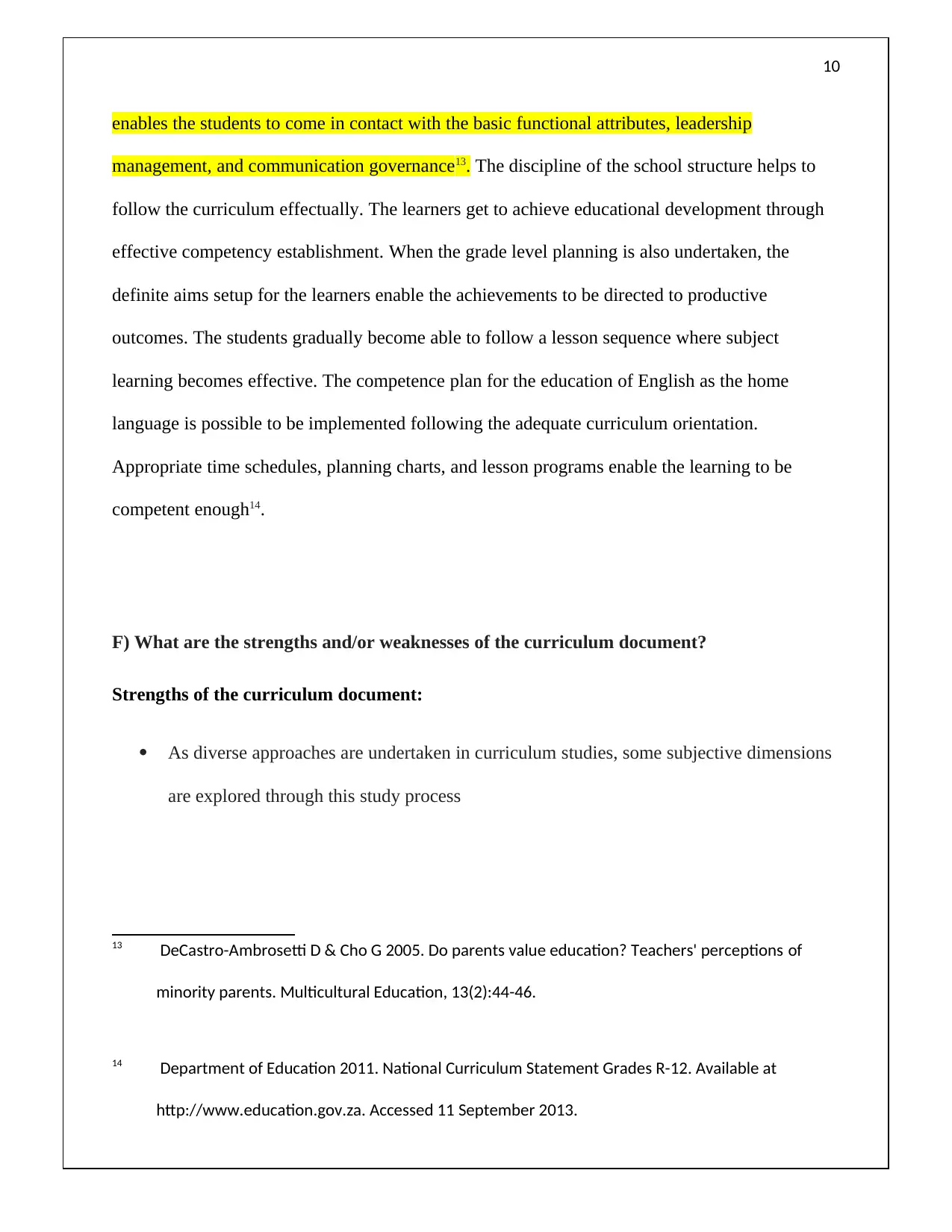
10
enables the students to come in contact with the basic functional attributes, leadership
management, and communication governance13. The discipline of the school structure helps to
follow the curriculum effectually. The learners get to achieve educational development through
effective competency establishment. When the grade level planning is also undertaken, the
definite aims setup for the learners enable the achievements to be directed to productive
outcomes. The students gradually become able to follow a lesson sequence where subject
learning becomes effective. The competence plan for the education of English as the home
language is possible to be implemented following the adequate curriculum orientation.
Appropriate time schedules, planning charts, and lesson programs enable the learning to be
competent enough14.
F) What are the strengths and/or weaknesses of the curriculum document?
Strengths of the curriculum document:
As diverse approaches are undertaken in curriculum studies, some subjective dimensions
are explored through this study process
13 DeCastro-Ambrosetti D & Cho G 2005. Do parents value education? Teachers' perceptions of
minority parents. Multicultural Education, 13(2):44-46.
14 Department of Education 2011. National Curriculum Statement Grades R-12. Available at
http://www.education.gov.za. Accessed 11 September 2013.
enables the students to come in contact with the basic functional attributes, leadership
management, and communication governance13. The discipline of the school structure helps to
follow the curriculum effectually. The learners get to achieve educational development through
effective competency establishment. When the grade level planning is also undertaken, the
definite aims setup for the learners enable the achievements to be directed to productive
outcomes. The students gradually become able to follow a lesson sequence where subject
learning becomes effective. The competence plan for the education of English as the home
language is possible to be implemented following the adequate curriculum orientation.
Appropriate time schedules, planning charts, and lesson programs enable the learning to be
competent enough14.
F) What are the strengths and/or weaknesses of the curriculum document?
Strengths of the curriculum document:
As diverse approaches are undertaken in curriculum studies, some subjective dimensions
are explored through this study process
13 DeCastro-Ambrosetti D & Cho G 2005. Do parents value education? Teachers' perceptions of
minority parents. Multicultural Education, 13(2):44-46.
14 Department of Education 2011. National Curriculum Statement Grades R-12. Available at
http://www.education.gov.za. Accessed 11 September 2013.
Paraphrase This Document
Need a fresh take? Get an instant paraphrase of this document with our AI Paraphraser
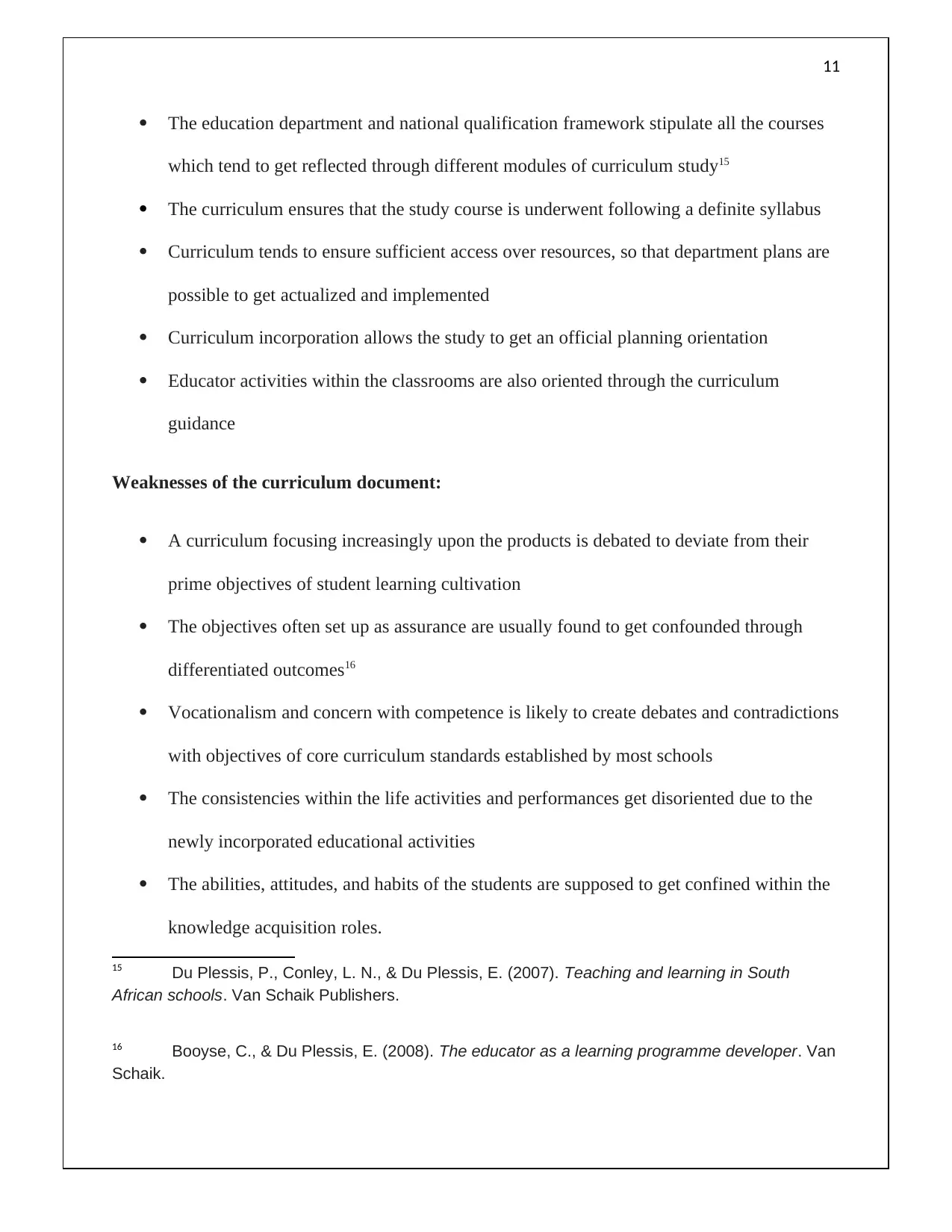
11
The education department and national qualification framework stipulate all the courses
which tend to get reflected through different modules of curriculum study15
The curriculum ensures that the study course is underwent following a definite syllabus
Curriculum tends to ensure sufficient access over resources, so that department plans are
possible to get actualized and implemented
Curriculum incorporation allows the study to get an official planning orientation
Educator activities within the classrooms are also oriented through the curriculum
guidance
Weaknesses of the curriculum document:
A curriculum focusing increasingly upon the products is debated to deviate from their
prime objectives of student learning cultivation
The objectives often set up as assurance are usually found to get confounded through
differentiated outcomes16
Vocationalism and concern with competence is likely to create debates and contradictions
with objectives of core curriculum standards established by most schools
The consistencies within the life activities and performances get disoriented due to the
newly incorporated educational activities
The abilities, attitudes, and habits of the students are supposed to get confined within the
knowledge acquisition roles.
15 Du Plessis, P., Conley, L. N., & Du Plessis, E. (2007). Teaching and learning in South
African schools. Van Schaik Publishers.
16 Booyse, C., & Du Plessis, E. (2008). The educator as a learning programme developer. Van
Schaik.
The education department and national qualification framework stipulate all the courses
which tend to get reflected through different modules of curriculum study15
The curriculum ensures that the study course is underwent following a definite syllabus
Curriculum tends to ensure sufficient access over resources, so that department plans are
possible to get actualized and implemented
Curriculum incorporation allows the study to get an official planning orientation
Educator activities within the classrooms are also oriented through the curriculum
guidance
Weaknesses of the curriculum document:
A curriculum focusing increasingly upon the products is debated to deviate from their
prime objectives of student learning cultivation
The objectives often set up as assurance are usually found to get confounded through
differentiated outcomes16
Vocationalism and concern with competence is likely to create debates and contradictions
with objectives of core curriculum standards established by most schools
The consistencies within the life activities and performances get disoriented due to the
newly incorporated educational activities
The abilities, attitudes, and habits of the students are supposed to get confined within the
knowledge acquisition roles.
15 Du Plessis, P., Conley, L. N., & Du Plessis, E. (2007). Teaching and learning in South
African schools. Van Schaik Publishers.
16 Booyse, C., & Du Plessis, E. (2008). The educator as a learning programme developer. Van
Schaik.
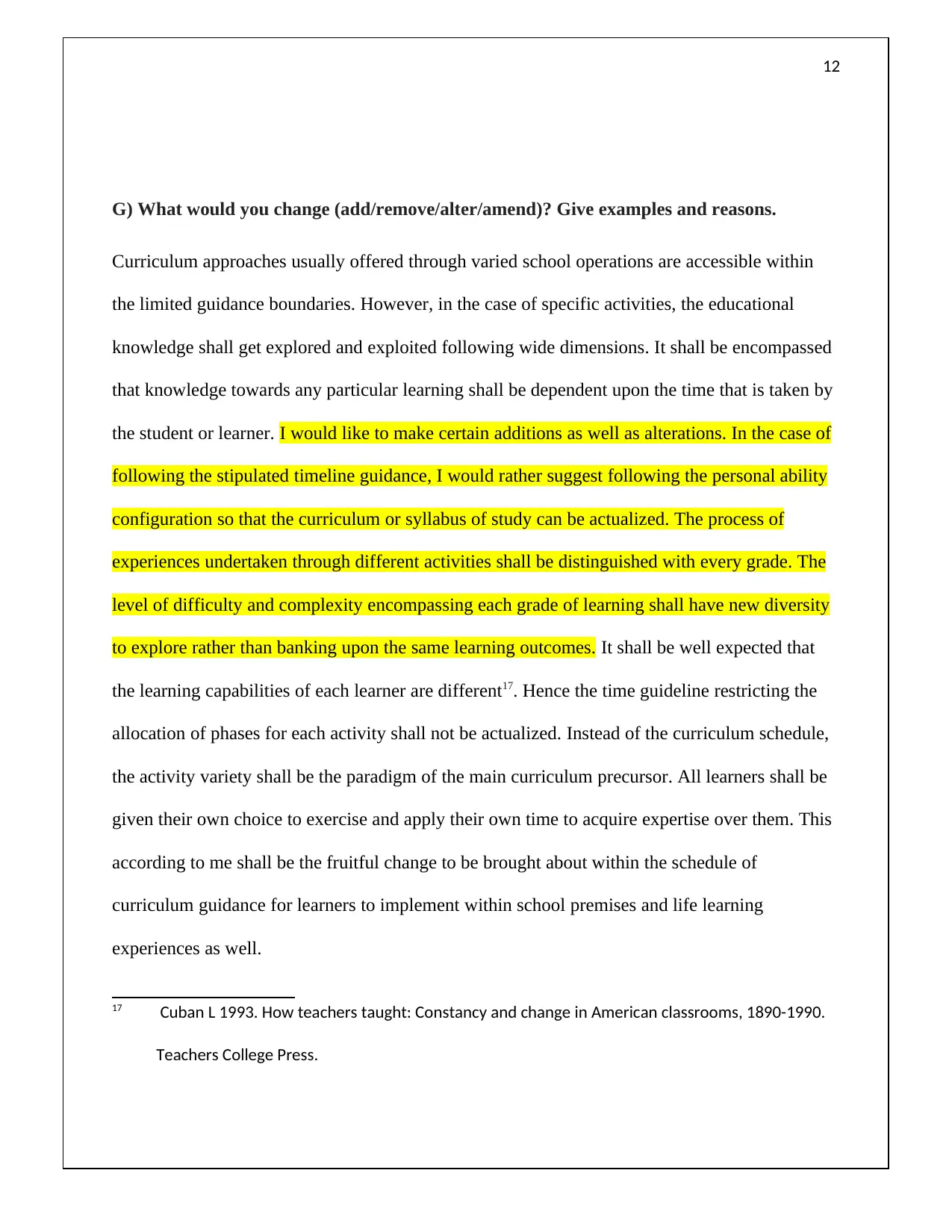
12
G) What would you change (add/remove/alter/amend)? Give examples and reasons.
Curriculum approaches usually offered through varied school operations are accessible within
the limited guidance boundaries. However, in the case of specific activities, the educational
knowledge shall get explored and exploited following wide dimensions. It shall be encompassed
that knowledge towards any particular learning shall be dependent upon the time that is taken by
the student or learner. I would like to make certain additions as well as alterations. In the case of
following the stipulated timeline guidance, I would rather suggest following the personal ability
configuration so that the curriculum or syllabus of study can be actualized. The process of
experiences undertaken through different activities shall be distinguished with every grade. The
level of difficulty and complexity encompassing each grade of learning shall have new diversity
to explore rather than banking upon the same learning outcomes. It shall be well expected that
the learning capabilities of each learner are different17. Hence the time guideline restricting the
allocation of phases for each activity shall not be actualized. Instead of the curriculum schedule,
the activity variety shall be the paradigm of the main curriculum precursor. All learners shall be
given their own choice to exercise and apply their own time to acquire expertise over them. This
according to me shall be the fruitful change to be brought about within the schedule of
curriculum guidance for learners to implement within school premises and life learning
experiences as well.
17 Cuban L 1993. How teachers taught: Constancy and change in American classrooms, 1890-1990.
Teachers College Press.
G) What would you change (add/remove/alter/amend)? Give examples and reasons.
Curriculum approaches usually offered through varied school operations are accessible within
the limited guidance boundaries. However, in the case of specific activities, the educational
knowledge shall get explored and exploited following wide dimensions. It shall be encompassed
that knowledge towards any particular learning shall be dependent upon the time that is taken by
the student or learner. I would like to make certain additions as well as alterations. In the case of
following the stipulated timeline guidance, I would rather suggest following the personal ability
configuration so that the curriculum or syllabus of study can be actualized. The process of
experiences undertaken through different activities shall be distinguished with every grade. The
level of difficulty and complexity encompassing each grade of learning shall have new diversity
to explore rather than banking upon the same learning outcomes. It shall be well expected that
the learning capabilities of each learner are different17. Hence the time guideline restricting the
allocation of phases for each activity shall not be actualized. Instead of the curriculum schedule,
the activity variety shall be the paradigm of the main curriculum precursor. All learners shall be
given their own choice to exercise and apply their own time to acquire expertise over them. This
according to me shall be the fruitful change to be brought about within the schedule of
curriculum guidance for learners to implement within school premises and life learning
experiences as well.
17 Cuban L 1993. How teachers taught: Constancy and change in American classrooms, 1890-1990.
Teachers College Press.
⊘ This is a preview!⊘
Do you want full access?
Subscribe today to unlock all pages.

Trusted by 1+ million students worldwide
1 out of 14
Related Documents
Your All-in-One AI-Powered Toolkit for Academic Success.
+13062052269
info@desklib.com
Available 24*7 on WhatsApp / Email
![[object Object]](/_next/static/media/star-bottom.7253800d.svg)
Unlock your academic potential
Copyright © 2020–2025 A2Z Services. All Rights Reserved. Developed and managed by ZUCOL.




